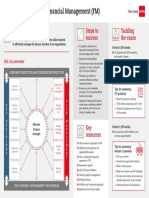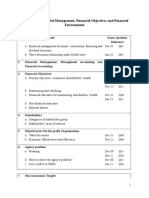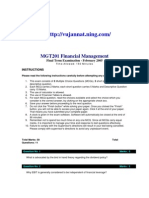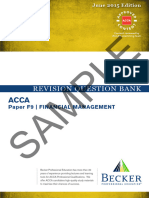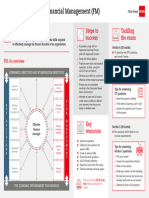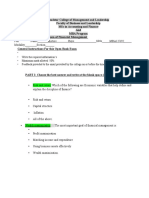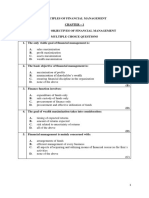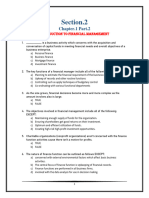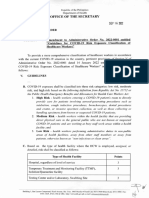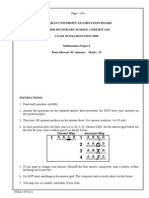ACCA
Applied Skills
Financial Management (FM)
EXAM KIT
�CONTENTS
Page
Index to questions and answers P.5
Analysis of past exams P.9
Exam Technique P.11
Exam-specific information P.13
Kaplan’s recommended revision approach P.16
The Kaplan Financial Management revision plan P.18
Mathematical tables and formulae sheet P.24
Section
1 Objective Test Questions – Section A 1
2 Objective Test Case Study Questions – Section B 59
3 Constructed Response (Long) Practice Questions – Section C 121
4 Answers to Objective Test Questions – Section A 167
5 Answers to Objective Test Case Study Questions – Section B 211
6 Answers to Constructed Response (Long) Practice Questions – Section C 261
7 Specimen Exam Questions 493
8 Answers to Specimen Exam Questions 511
KA PL AN P U BLI SH IN G P. 3
� IN DE X TO Q UE S T ION S A N D A N S WE R S
Page number
Question Answer
SECTION A-TYPE QUESTIONS 1–220
Financial Management Function 1–22 1 167
Financial Management Environment 23–54 6 169
Working Capital Management 55–88 14 174
Investment Appraisal 89–118 23 182
Business Finance and Cost of Capital 119–157 32 189
Business Valuations 158–188 41 197
Risk Management 189–220 50 203
Questions with online debriefs in section A are Qs 20, 21, 25, 33, 47
SECTION B-TYPE QUESTIONS 221–264
Financial Management Function and Environment 221–222 59 211
Working Capital Management 223–228 63 213
Investment Appraisal 229–235 71 220
Business Finance and Cost of Capital 236–243 81 228
Business Valuations 244–254 91 236
Risk Management 255–264 107 248
Questions with online debriefs in section B are Qs 250, 262
SECTION C-TYPE QUESTIONS
WORKING CAPITAL MANAGEMENT – EXAM STYLE QUESTIONS
265 FLG Co 121 261 June 08
266 KXP Co 122 264 Dec 12
267 HGR Co 123 269 June 09
268 Anjo 124 274 –
269 WQZ Co 126 275 Dec 10
270 Flit Co 127 280 Dec 14
271 Oscar Co 128 285 Sep/Dec 18
272 Dusty Co 129 290 Sep/Dec 19
273 Pumice Co 130 295 Mar/Jul 20
274 Kandy Co 131 301 Sep/Dec 21
275 Purdy Co 132 307 Sep/Dec 22
INVESTMENT APPRAISAL – EXAM STYLE QUESTIONS
276 Warden Co 133 313 Dec 11
277 Duo Co 133 317 Dec 07
278 OKM Co 134 322 June 10
279 Hraxin Co 135 326 Jun 15
280 Hebac Co 136 330 Sep 16
281 Vyxyn Co 137 333 Mar/Jun 17
KA PL AN P U BLI SH IN G P. 7
�EXAM-SPECIFIC INFORMATION
THE EXAM
FORMAT OF THE EXAM
The exam will be in THREE sections, and will be a mix of narrative and computational answers.
All questions are compulsory.
Number of marks
Section A: Fifteen objective test questions of 2 marks each 30
Section B: Three objective test case studies
– five questions per case study of 2 marks each 30
Section C: Two constructed response (long) questions, mainly from
the syllabus areas of working capital management,
investment appraisal and business finance:
Question 1 20
Question 2 20
––––
100
––––
Total time allowed: 3 hours (plus 10 minutes to read the exam instructions).
Note that:
• the Financial Management exam will have both a discursive and computational element. The
objective test questions and the objective test case study questions will therefore include a
mix of calculation-based and explanation-based questions.
• there is likely to be a discussion element included in the constructed response questions in
Section C.
PASS MARK
The pass mark for all ACCA Qualification examination exams is 50%.
KA PL AN P U BLI SH IN G P. 13
�Section 1
OBJECTIVE TEST QUESTIONS –
SECTION A
Each question is worth two marks.
FINANCIAL MANAGEMENT FUNCTION
1 In relation to the financial management of a company, which of the following provides the
best definition of a firm’s primary financial objective?
A To achieve long-term growth in earnings
B To maximise the level of annual dividends
C To maximise the wealth of its ordinary shareholders
D To maximise the level of annual profits
2 Indicate, by clicking in the relevant boxes, whether the following objectives are financial or
non-financial objectives of a company.
Objective Financial Non-financial
Maximisation of market share
Earnings growth
Sales revenue growth
Achieving a target level of customer satisfaction
Achieving a target level of return on capital employed
3 Which THREE of the following are the main types of decision facing the financial manager
in a company?
A Income decision
B Investment decision
C Dividend decision
D Financing decision
E Appraisal decision
F Budget decision
KA PL AN P U BLI SH IN G 1
�FM : FIN AN CI AL MA N A GE ME N T
4 Which TWO of the following are examples of financial objectives that a company might
choose to pursue?
A Dealing honestly and fairly with customers on all occasions
B Provision of good working conditions and industrial relations
C Earning above a particular level of return on capital employed
D Producing environmentally friendly products
E Restricting the level of gearing to below a specified target level
5 Value for money is an important objective for not-for-profit organisations.
Which of the following actions is consistent with increasing value for money?
A Using a cheaper source of goods and thereby decreasing the quality of not-for-profit
organisation services
B Searching for ways to diversify the finances of the not-for-profit organisation
C Decreasing waste in the provision of a service by the not-for-profit organisation
D Focusing on meeting the financial objectives of the not-for-profit organization
6 Which of the following is LEAST likely to fall within financial management?
A The dividend payment to shareholders is increased
B Funds are raised to finance an investment project
C Surplus assets are sold off
D A report is produced comparing actual results to budget
7 Indicate, by clicking in the relevant boxes, whether the following statements are true or
false.
Statement True False
Financial management is concerned with the long-term raising
of finance and the allocation and control of resources
Management accounting is concerned with providing
information for the more day-to-day functions of control and
decision-making
Financial accounting is concerned with providing information
about the historical results of past plans and decisions
2 KA PL AN P U BLI SH IN G
�You are viewing a sample
Interested in the full version?
Purchase on Kaplan Publishing


